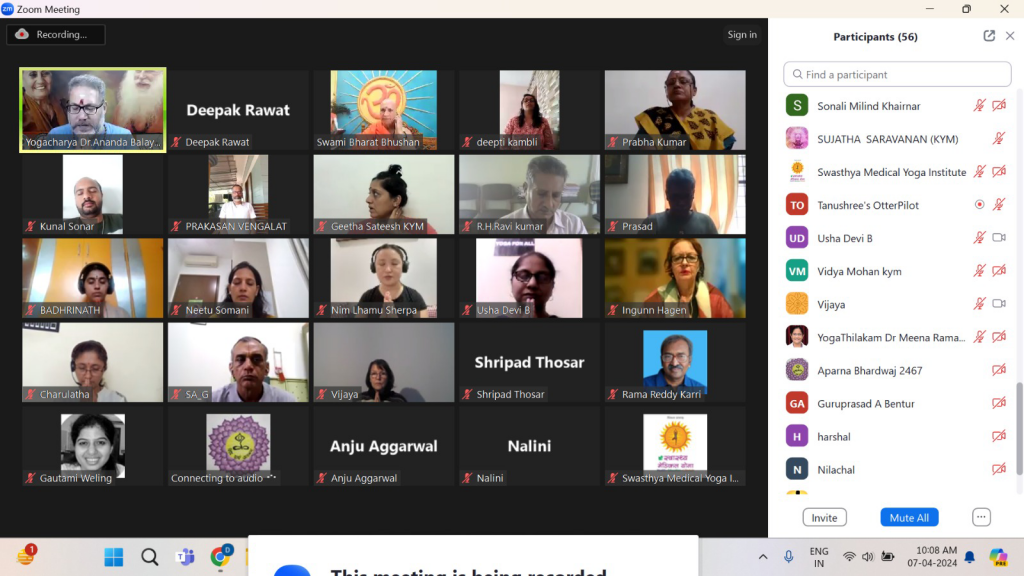The Indian Yoga Association (IYA), Uttar Pradesh Chapter, played a significant role in the Women Empowerment Seminar organized by the Institute Innovation Council (IIC) at SD College of Commerce. The event was a resounding success, bringing together experts and dignitaries to discuss critical issues surrounding…
Swami Bharat Bhushan Ji
A brief report by Yogsadhaka Nilachal
Yoga Chikitsa Ratna Swami Bharat Bhushan ji is an Indian yoga guru who was honoured with one of the highest Civilian Award of India, Padma Shri for Yoga in 1991 delves into the intricacies of Yoga in the second session of the Cycle Program held on April 7, 2024.
Swami Bharat Bhushan ji started the discussion with the most important query of all: “What is Yoga?” He further mentioned that without initially understanding yoga, it is impossible to fully comprehend Yoga Chikitsa or Yoga Therapy.
He beautifully explained how people perceive yoga differently, which may affect the methodology to treat the care seekers. Some yoga enthusiasts think yoga is only asana. Some perceive it as only dharna or dhyan and so on. But none is correct. He explained, Yoga is more than asana or pranayama or any other individual practices.

Further he explained, humanity has explored many paths in its quest for well-being, from modern medical technology to age-old spiritual traditions. Of these, Yoga Chikitsa, or Yoga Therapy, is particularly noteworthy as a highly effective approach that heals mental, emotional, and spiritual disorders in addition to physical problems. Yoga Chikitsa, with its roots in spirituality and holistic principles, provides a thorough method for self-discovery and healing.
Fig. Swami Bharat Bhushan ji narrated a beautiful story about blind people who came across an elephant and described it as they understand but not as it is. Similarly, Yoga is also more than asana or pranayama or any other individual yogic practices.

Understanding Yoga Holistically:
Yoga can be understood holistically as a medicinal system that treats social, mental, physical, and spiritual ailments. It is not just a set of practices. Drawing on classical theories such as Sankhya, Yoga explores the nature of ‘Dukha’ or sufferings and its various sources. Yoga is a complete method that addresses the underlying causes of suffering and promotes holistic well-being, whilst conventional remedies only offer temporary relief.
दुःखत्रयाभिघाताज्जिज्ञासा तदभिघातके हेतौ ।
दृष्टे साऽपार्था चेन्नैकान्तात्यन्ततोऽभावात् ॥१ ॥
duḥkha-trayā-abhighātāt-jijñāsā tat-abhighātake hetau |
dṛṣṭe sā-apārthā cet na-ekānta-atyantataḥ abhāvāt ||
- Sāṃkhya Kārikā verse 1
“Within and around us is an absence
of certainty and permanence.”
“From the torment caused by the three kinds of dukkha or suffering, a desire arises for inquiry into the means of terminating this suffering. If it is said that this desire is superfluous since visible means exist, we reply, not so; because these visible means provide a solution which lacks certainty and permanency.”

duḥkha – suffering, pain, sorrowful
traya – the three, triple, threefold, consisting of 3, of 3 kinds
abhighāta – infliction of injury, damage
tat – that, this
abhighātaka – counteracting, removing
hetu – cause, cause of; motive; reason for
dṛṣṭa – seen, looked at, beheld, perceived, viewed, observed, noticed; visible, apparent, observable; considered, regarded; treated of; appearing, manifested; occurring, found; experienced, suffered, endured; seen in the mind, devised, imagined, learned,
apārthā – without any object, useless, unprofitable, worthless
cit – awareness, consciousness; to be aware of; to cause to comprehend, to observe; perceive
na – no; not; nor, neither
ekānta – solely, only, exclusively; absoluteness, certainty
atyanta – absolutely, completely, to the end; endless, unbroken, perpetual; permanency
abhāva – non-appearance, non-existence, absence, nullity
jijñāsā – asking; search; desire of knowing, curiosity, inquisitiveness; curiosity, spirit of learning; search, investigation, test, examination
The three kinds of suffering:
Ādhyātmika (internal)
Physical – At the physical level, suffering can be caused by physical injury, fever, or any ailment or disease. Most commentators point to Ayurveda where it is stated that disease is caused by the imbalance of the three doshas – vata, pitta, kapha;
Mental – separation from loved one; inability to get rid of objects of dislike; six enemies of the mind (shad-ripu) – lust (kāma), anger (krodha), greed (lobha), infatuation (moha), arrogance (mada), jealousy (mātsarya); fear; grief etc.
Ādhibhautika (external) – caused by man, beast, birds, reptiles, plants and other inanimate objects. In the ancient text, Vāyu Purāna, the following classification is given for all living beings:
Udbhija (उद्भिज): Sprouting – trees, plants etc.
Jarāyuja (जरायुज) creatures born of wombs – viviparous beings – mammals (humans, animals etc.)
Svedaja (स्वेदज). born of sweat or moisture, Ants, worms, etc.
Aṇḍaja (अण्डज) oviparous – born out of eggs – Birds, Fish etc.
ādhidaivika (divine) – cyclone, tsunami, earthquake, fire, plague, flood, famine etc.
While acknowledging the efficacy of measures like medicine and safety precautions, Swami ji suggested that these visible means only offer temporary relief. He also said that ultimate liberation from suffering requires confronting deeper existential realities, such as solitude and absence. This existential perspective challenges individuals to seek solutions beyond superficial remedies and confront the inherent uncertainties and limitations of human existence. He encouraged a comprehensive understanding of Yoga as a profound system for addressing the complexities of human suffering and promoting holistic well-being across physical, mental, and spiritual dimensions. To realise the full potential of Yoga, Swami ji suggested the practitioners to comprehend its broader dimensions, including its spiritual and intellectual aspects.
Swami Bharat Bhushan ji mentioned actual cases where people were exposed to COVID-19 but were able to withstand it because of their robust immune systems and mental equilibrium that they had developed via yoga. This demonstrates how yoga not only improves physical health but also fosters resilience in the face of hardship and emotional well-being.
He also said that the benefits of yoga go far beyond treating specific physical conditions. It highlights that yoga tools balance vata, pitta and kapha, targeting several body systems, such as the neurological, musculoskeletal, and cardiovascular systems. Furthermore, Yoga’s holistic approach not only heals existing conditions but also boosts immunity to help prevent disease.
Deeper Dimensions of Yoga:
Yoga has deeper aspects that result in significant transformation, beyond just asanas and pranayama. The fundamentals of yoga practice are yama and niyama. Practitioners of Yoga darshan explore this relationship of discovering the relevance of techniques like pranayama in controlling the mind and prana, which eventually results in increased consciousness and mindfulness.
Swami ji shared an amazing story to demonstrate the transformative power of yoga. He told the story of a doctor who had previously been skeptical and had personally experienced how Yoga may go against accepted scientific theories. Despite his initial doubts, the doctor included Yogic practices in the child’s regimen since he was worried about his grandson’s height. To his astonishment, after three years of consistent practice, the child’s height significantly increased, defying the doctor’s expectations and scientific norms.
This anecdote serves as a compelling example of how Yoga can challenge established scientific paradigms and offer unconventional solutions. It highlights the ability of Yoga to defy limitations imposed by age and conventional medical understanding. Swami ji said that such instances prompt scientists to reconsider their preconceptions and explore the potential of Yoga in promoting holistic health and well-being.
Swami ji emphasized the inclusive nature of Yoga, welcoming diverse perspectives and approaches under the umbrella of the Indian Yoga Association. He stressed the importance of viewing Yoga holistically, not merely as a set of physically visible practices such as asana but as a comprehensive system for personal growth and well-being. Swami ji portrayed the practice of Yoga as a journey of self-discovery and empowerment, offering individuals the tools to unlock their full potential and lead fulfilling lives. Swami ji believes that yoga is a way of life based on experimentation and personal discovery rather than just a business venture.
Swami ji also rejected the idea that practicing yoga will help anyone work miracles or accomplish amazing feats. On the contrary, he emphasised that yoga is a magical discipline that may be experienced via individual sadhana (spiritual practice). He encouraged practitioners to explore the transformative potential of Yoga in controlling the senses, cultivating inner peace, and fostering holistic health.
Yama
Niyama
Asana
Pranayama
Pratyahar
Dharna
Dhyan
Aahar
Vihaar
Aachar
Vichar
Chintan
Charitra
Vyavhar
Swadhyay
Seva
Satsang
Guna
Karma etc..,
The Qualified Seeker
Becoming a worthy recipient of Yoga knowledge requires discipline, humility, and regular practice. The concept of the Adhikari, the qualified seeker or practitioner, emphasizes the importance of systematic study and self-inquiry. Reflecting on the transient nature of life, Swami ji calls for a holistic approach to health and well-being, grounded in the interconnectedness between humans and nature.
Swami ji clarified that being healthy is not an end goal but an ongoing process of maintaining balance and resilience in the face of life’s challenges. Even the strongest and healthiest individuals are not immune to setbacks or crises. However, through the practice of Yoga, individuals can develop the mental fortitude and emotional stability needed to navigate through adversity with grace and strength.
Swami ji made connections between achieving mental and spiritual well-being and the physical components of yoga, such as mastering asanas with balance and skill. He emphasised that real health can only be attained when a person is at peace with their inner self, as the Bhagavad Gita says. Finding inner peace and satisfaction and overcoming hardships and external circumstances is more important than being physically strong or living a disease-free life.
नास्ति बुद्धिरयुक्तस्य न चायुक्तस्य भावना |
न चाभावयत: शान्तिरशान्तस्य कुत: सुखम् || 66||
nāsti buddhir-ayuktasya na chāyuktasya bhāvanā
na chābhāvayataḥ śhāntir aśhāntasya kutaḥ sukham
-Bhagwat Geeta 2/66
an undisciplined person, who has not controlled the mind and senses, can neither have a resolute intellect nor steady contemplation on God. For one who never unites the mind with God there is no peace; and how can one who lacks peace be happy?
तपस्विभ्योऽधिकोयोगी ज्ञानिभ्योऽपिमतोऽधिक:|
कर्मिभ्यश्चाधिकोयोगी तस्माद्योगीभवार्जुन ||
tapasvibhyo ’dhiko yogī jñānibhyo ’pi mato ’dhikaḥ
karmibhyaśh chādhiko yogī tasmād yogī bhavārjuna
-Bhagwat Geeta 6/46
A yogi is superior to the tapasvī (ascetic), superior to the jñānī (a person of learning), and even superior to the karmī (ritualistic performer). Therefore, O Arjun, strive to be a yogi.
Swami ji underscores that being healthy is not an end goal but an ongoing process of maintaining balance and resilience in the face of life’s challenges. Nobody is immune to problems or crises, not even the healthiest and strongest people. But people can acquire the mental strength and emotional stability required to face hardship head-on and emerge stronger by practicing yoga.
Swami ji also clarified the importance of integrating lifestyle elements like daily routine and diet into yoga practice. He highlighted the importance of self-control and moderation, distinguishing between ‘conquering’ and ‘killing’ desires. The goal is not to suppress natural urges but to develop ‘sanyam’ or restraint and tolerance, enabling individuals to navigate through life’s challenges with equanimity.
Conclusion:
In conclusion, the intersection of Spirituality and Yoga Chikitsa offers a profound path to holistic well-being. Through unity, holistic understanding, practical application, exploration of deeper dimensions, and personal transformation, individuals can embark on a journey of self-discovery and empowerment. Embracing Yoga as more than just a physical practice, but a comprehensive system for holistic growth, is key to unlocking its transformative potential and leading a fulfilling life. Swami ji reiterates that yoga is a profound philosophy and way of life, not just a physical practice. It gives people the ability to develop spiritual development, inner serenity, and resilience. Through the practice of yoga, people can adopt a preventative medicine approach and achieve overall well-being, leading to meaningful lives with mental clarity, physical energy, and spiritual peace.
















